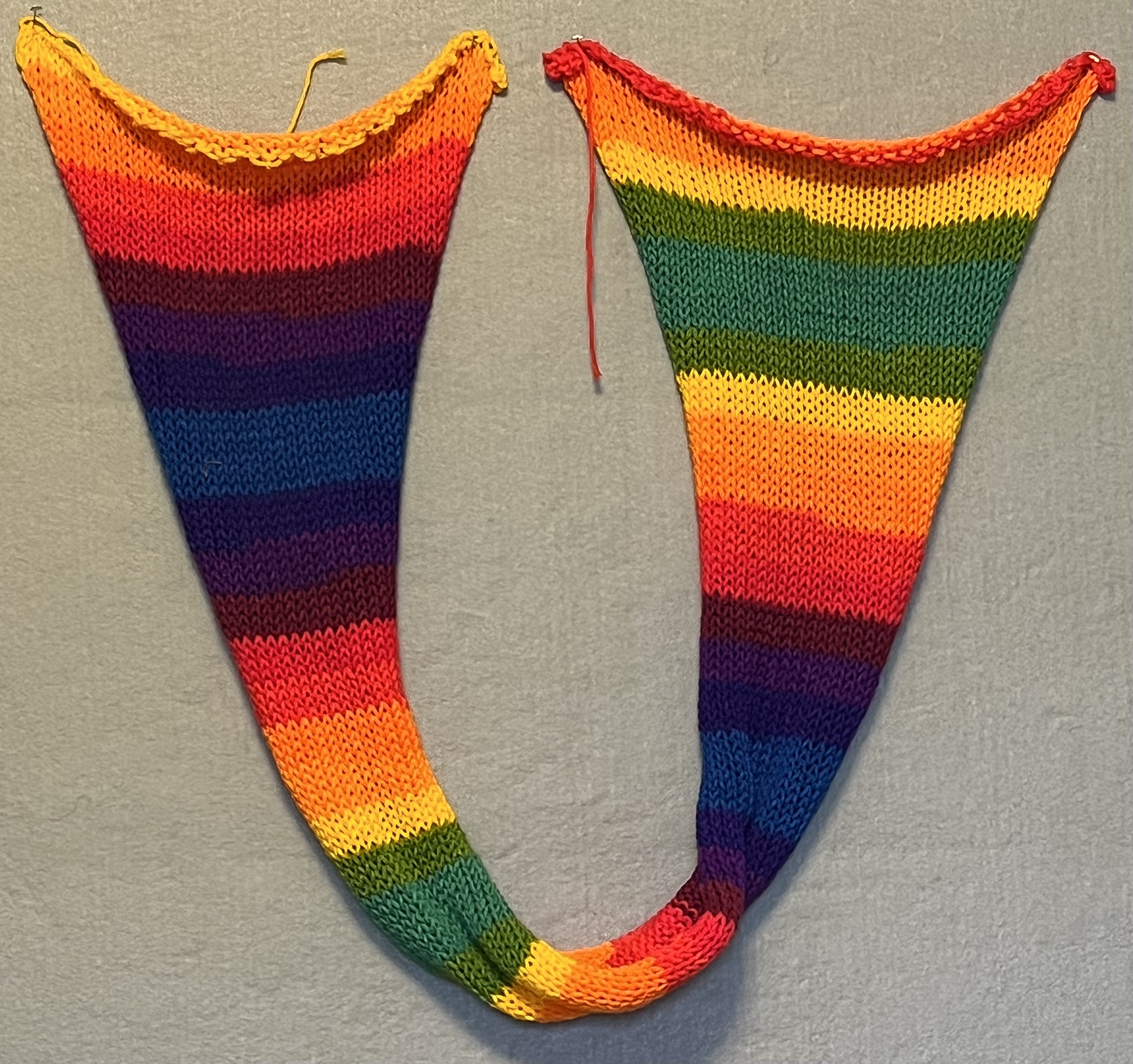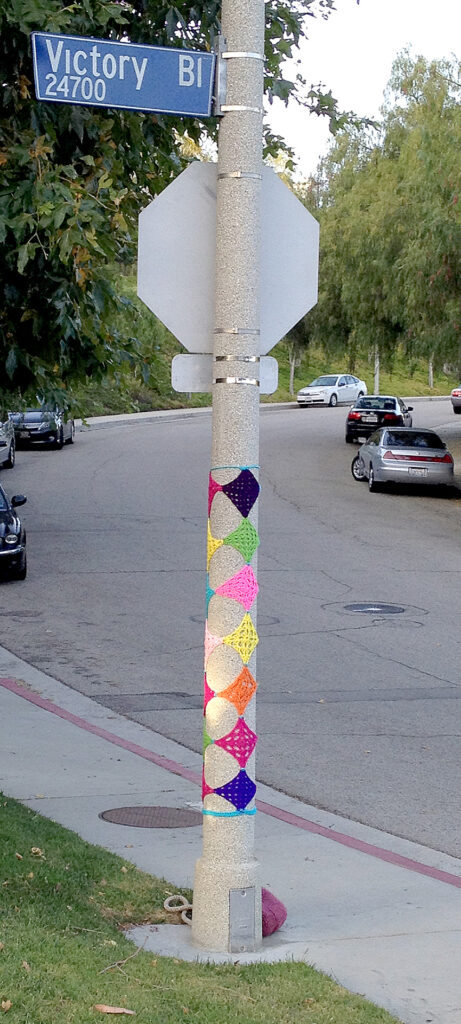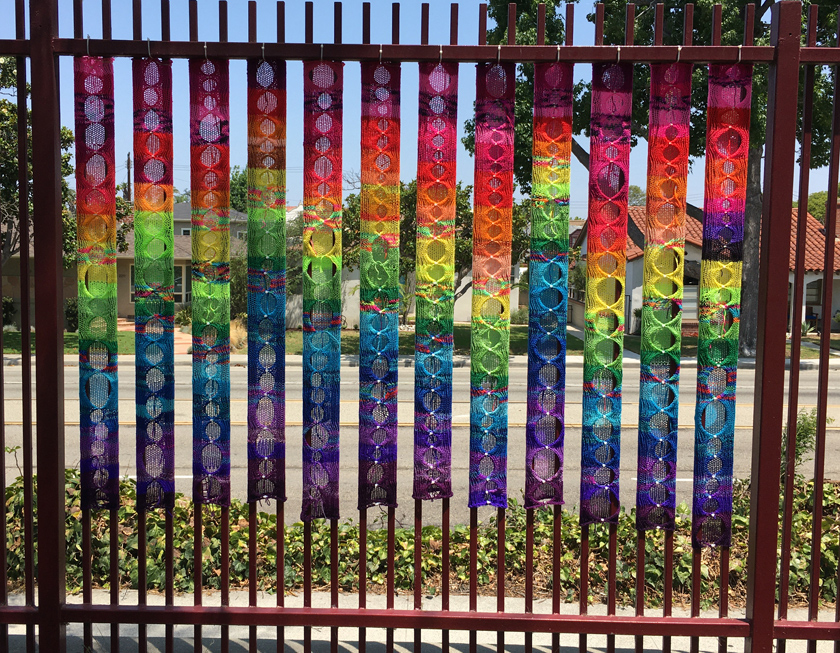I’m not as ballsy as people might think, probably never have been. It’s possible that being foul mouthed, with loudly stated strong opinions has been misconstrued for actual boldness.
As you may know, I am a yarnbomber. I have done wonderful yarnbombs with permission, many with Yarnbombing Los Angeles. I have gorilla yarnbombed without permission many places, preferring the West San Fernando Valley.
During the lockdown of 2020, I did several stop signs in my own neighborhood. I made a bunch of sign post covers. There were people who passed by while I was installing who were very positive and supportive. Come called out, “thank you!” I did some of the prominent intersections of the main streets that pass through the neighborhood, the streets that get the most traffic. I did all four stop signs of two of the high traffic intersections.

Then they disappeared far too quickly.
I’ve had this happen before (I’m looking at you, Reseda). I have friends who choose to interpret this as people loving them so much they took the yarnbombs for themselves. I applaud my friends for looking on the bright side, that’s nice. I just don’t think so. What I really feel is the yarnbombs offended someone and they were removed.
These yarnbombs make people happy, I’ve been told over and over. But I also know there are people out there just being people.
In 2020, around the time of my disappearing signpost covers, there was a conversation on Nextdoor – you know, the great social platform for lost pets and hostile neighbors. There was a guy I’ll call Mr. Unhappy, who complained about the painted utility boxes on the corners near the high school. He wanted, no demanded to know if those were done with or without permission. If with, then it was ok, he stated. If without, then it was a crime, and Mr. Unhappy was there to call it out.
Here is how I did the social math: the City has an app now for requesting services. I’ve reported pot holes and they got filled; I’ve requested bulky item pick up the day before trash day and the truck has come to take it away. Long ago, in the last century, a citizen had to call the street services department, had to go through the worst automated menu imaginable, wait on hold if they could even reach the hold, and then report an offensive item attached to a stop sign.
After the yarnbombs disappeared, I went to the internet. It wasn’t even a deep dive, I only had to wade in up to my ankles to find out that it is indeed against City ordinances to attach things to municipal signs. It is actually illegal to Yarnbomb stop signs.
So, I figured someone took umbrage at the law being flouted, pulled out their phone, and with just a few taps, became a crimefighter.
Dissolve to Present Day.
(I would’ve said fast forward, but you know there was nothing fast about these past three years)
Two weeks ago, it was the First Friday Art Walk in the West End of Chastworth. While hanging out there, I knitted a yarny piece on my little hand crank machine. My first idea was to attach this to a street light pole there at the west end of the street. There’s a nice light pole in front of this cool game café out there.
But I hesitated.

This piece is pretty much on-the-nose Pride Rainbow, and it’s June. Now here’s my problem. For years the West Valley has had a reputation for being conservative. My concern is some kind of backlash. What if this brings some shit unpleasantness down on the businesses out there? What if someone targets the business I put the Rainbow Pride Yarnbomb in front of?
Am I being chicken, I wondered or prudent, thinking negatively, or realistically? I went into the café and asked for the owner. He wasn’t there, and the employee told me that my instincts might have been well founded. He said there had been some kind of street art on some poles near the café. Someone claiming to be “from the city” had come in to tell them to take the objects down or they would be fined – even though the poles weren’t on the property of the café, and they hadn’t put up the art.
I dissected this information with my fiber/fabric colleagues. We figured that a worker or manager with Department of Street Services would not walk into a business making threats. We have our theory for who this person “from the city” might have been.
For those who don’t know our little village of Los Angeles well, we have a layer of city government that exists on the neighborhood level, that any citizen can be elected to serve on. There are 99 of these entities. When you’ve lived here a while, you learn the neighborhoods of Los Angeles are very much like their own small cities, each with its own character. Some of our neighborhoods have quite a collection of characters.
This layer of city governance has no legislative duties, no enforcement powers, and really, no ability to levy fines on anyone. I know what this layer of government is, I remember when it was formed and instituted. I’m avoiding saying it’s name. I’ve lived in LA 2/3 of my life, I love LA, and I love the San Fernando Valley. But I don’t want to draw the ire of the local fiefdom.

But I digress.
For the moment, I’m not sure what I will do with my Rainbow Yarnbomb. Check back here.

